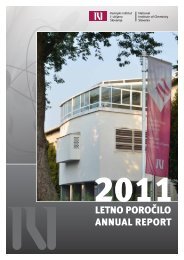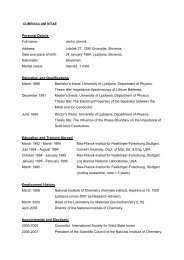Letno poročilo 2005
Letno poročilo 2005
Letno poročilo 2005
Create successful ePaper yourself
Turn your PDF publications into a flip-book with our unique Google optimized e-Paper software.
Laboratorij za biotehnologijo<br />
Laboratory of Biotechnology<br />
uporabljene tudi preventivno za terapijo gramnegativne<br />
sepse«, pravi Sunil David iz Univerze<br />
v Kansasu v ZDA.<br />
»Za naravni antibioti~ni lipopeptid polimiksin B<br />
je `e dolgo znano, da nevtralizira bakterijski<br />
endotoksin, vendar njegova toksi~nost prepre-<br />
~uje uporabo kot sistemski antibiotik«, pravi<br />
Jerala. »Za lipopoliamine vemo, da nevtralizirajo<br />
endotoksin, ne da bi bili toksi~ni za sesalske<br />
celice, vendar doslej znane spojine niso imele<br />
antimikrobnega delovanja«. Njegova skupina<br />
raziskuje sinteti~ne lipopeptide, med katerimi<br />
posku{ajo pripraviti tak{ne, ki bi posnemali<br />
polimiksin B, ob tem pa bi se izognili njegovi<br />
toksi~nosti za gostiteljske celice.<br />
»Pri na{ih raziskavah smo ob izvajanju kontrol<br />
opazili, da ima ena od izhodnih sestavin -<br />
oleilamin, ne pa tudi sorodne spojine, antimikrobno<br />
delovanje, kar nas je navedlo, da<br />
razi{~emo strukturne zahteve za to aktivnost«,<br />
pravi Jerala. »Lipid A, neobhoden del strukture<br />
endotoksina, je zelo ohranjen med bakterijami.<br />
Z analizo njegove strukture smo ugotovili, da<br />
bi morala imeti spojina, ki bi nevtralizirala<br />
endotoksin, hidrofobno povr{ino ter par<br />
kationskih mest na ustrezni razdalji, tako da bi<br />
se vezali na dve fosfatni skupini lipida A«.<br />
Z upo{tevanjem teh zahtev so raziskovalci<br />
sintetizirali skupino spojin in testirali njihovo<br />
delovanje na bakterije. Pokazalo se je, da je<br />
dejansko mo`no kombinirati tako antimikrobno<br />
aktivnost kot tudi nevtralizacijo endotoksina,<br />
dodatno pa spojine za razliko od polimiksina B<br />
presenetljivo dobro delujejo tudi proti grampozitivnim<br />
bakterijam.<br />
»Predvidevamo, da bodo bakterije te`ko razvile<br />
odpornost proti oleoilaminom«, pravi Jerala.<br />
»Verjetno bodo te spojine imele podobno<br />
delovanje kot naravni kationski antimikrobni<br />
peptidi, proti katerim je odpornost dokaj redka,<br />
saj je bistvena sprememba lastnosti membrane<br />
za bakterije neugodna. Bakterije, ki so odporne<br />
proti kationskim peptidom, imajo obi~ajno<br />
nizko virulenco in jih organizem tudi la`je<br />
inaktivira s fagocitozo«.<br />
150<br />
the therapy of gram-negative sepsis,” says Sunil<br />
A. David, of the University of Kansas, Lawrence.<br />
A lipopeptide compound called polymyxin B<br />
“has long been known to neutralize bacterial<br />
endotoxin, but its toxicity prevents its use as a<br />
systemic drug,” says Jerala. Lipopolyamines had<br />
been known to neutralize endotoxin (AKA lipopolysaccharide<br />
¢LPS¥ without toxicity to<br />
eukaryotic cells, says Jerala, but they lacked<br />
antibiotic activity. His group had been experimenting<br />
with synthetic lipopeptides, trying to<br />
find one that one mimic polymyxin B’s LPS-neutralizing<br />
without killing eukaryotic cells. “We<br />
noticed that oleylamine but not other saturated<br />
alkylamines had antimicrobial activity, which<br />
prompted us to investigate the structural requirements<br />
for the activity,” says Jerala. Part of<br />
the structure of the “lipid A” section of LPS is<br />
highly conserved across the bacteria. The details<br />
of this structure suggested that an LPS<br />
neutralizing agent should have a water-repelling<br />
surface, and a pair of “cationic interaction<br />
sites” that would be spaced such that they could<br />
interact with the two phosphate groups of lipid<br />
A. The researchers then synthesized novel<br />
oleoylamines incorporating these properties,<br />
and then tested them against bacteria. The results<br />
“showed that it is indeed possible to combine<br />
both antimicrobial activity and neutralization<br />
of LPS and that surprisingly, the compounds<br />
showed also comparable activity against grampositive<br />
bacteria. Bacteria would probably have<br />
trouble developing resistance to oleoylamine<br />
antibiotics, says Jerala. “I believe that oleylamines<br />
probably would behave like cationic antimicrobial<br />
peptides, where resistance is quite<br />
rare since it is expensive for the bacteria to<br />
modify the properties of their membrane,” he<br />
says. “Bacteria resistance to cationic antimicrobial<br />
peptides usually have attenuated virulence<br />
and are more efficiently inactivated by<br />
phagocytes.”







